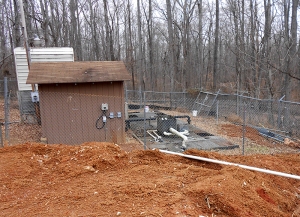(Submitted by Park Superintendent Kelley King)
At the end of March, Haw River State Park sent its old wastewater treatment plant packing and replaced it with a “subsurface field treatment” system. The new system reduces environmental impacts and operating costs.
A 2010 plan was to renovate the 25-year-old plant. But, concerns about proposed water quality rules for the Jordan Lake watershed led to the decision to keep the park’s treated wastewater out of the Haw River altogether.

As the parks system’s first residential environmental education center, it’s vitally important that the park operates with a commitment to environmental protection. Having a failing treatment plant that fed indirectly into the Haw River (and ultimately Jordan Lake) simply was not acceptable. In addition, the amount of water and energy needed to operate the aging plant was substantial.
Water consumption is somewhat challenging to calculate since the park is served by well water. But, there is a very clear picture of energy use and cost savings. Comparing 2013 to 2014, energy costs are now 1/13th the amount for the old system.
Haw River State Park strives to be green, but it’s also good to save some green. The park is saving over $450 a month on its power bill, but the savings do not stop there. County and state regulations require daily inspections of a wastewater treatment plant by a certified technician. That had cost the state park $1,700 a month. The plant’s advanced age and seasonal fluctuations in the number of guests were significant factors affecting compliance.


Without getting too much into the nitty-gritty (and somewhat smelly) side of running a wastewater treatment plant, bacteria living in the plant serve to break down everything that flows through. During low-visitation periods, such as mid-winter, the bacteria could die off because they aren’t being fed enough. In order to maintain the bacteria, staff would purchase large bags of dog food to keep them alive or introduce sludge brought to the park. Neither option was inexpensive. When the park was at capacity, staff would have to hire another company to pump out what the plant couldn’t handle, costing up to $3,000 a year.
The bottom-line savings considering power bills, technicians and additional costs is nearly $30,000 a year using the new subsurface system.
The subsurface system requires very little maintenance, since an old farm field is perfectly suited for spray application. The field must be kept clear of trees, but staff was already regularly clearing it with a bush-hog, so that hasn’t added to the workload.
The last benefit of the new subsurface system isn’t monetary or physical, but one of aesthetics. The old plant was not only an eyesore, but considering the noise and foul smells, passing it while walking along one of the park’s main trails to the lake was sometimes not as serene as one would like. That experience has been improved tremendously.

